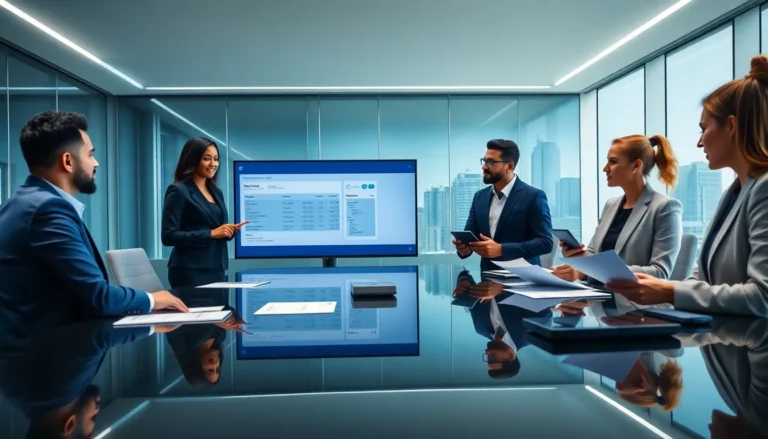Table of Contents
ToggleIn today’s tech-driven world, understanding PC hardware and software is as essential as knowing how to use a toaster without burning the bread. Whether you’re a seasoned IT guru or just someone trying to navigate the digital jungle, knowing the basics can save you from a meltdown—both in your computer and your sanity.
Overview of IT Essentials PC Hardware and Software
Understanding the basic components of PC hardware and software forms the foundation of IT essentials. Essential hardware includes the central processing unit (CPU), which handles instructions, and the motherboard, which connects all components. Memory, such as random access memory (RAM), temporarily stores data, while storage devices like hard disk drives (HDD) or solid-state drives (SSD) provide long-term data retention.
Peripheral devices enhance user interaction. Keyboards, mice, and monitors allow efficient input and output. Networking equipment, like routers and switches, enables communication between devices. These components contribute significantly to a computer’s functionality and performance.
Software plays a crucial role in the operation of hardware. Operating systems, including Windows, macOS, and Linux, manage hardware resources and provide essential user interfaces. Application software, like word processors and web browsers, fulfills specific user tasks. Understanding software licenses and installation processes also enhances user proficiency.
Maintenance of both hardware and software is essential. Regular updates to software applications keep systems secure and efficient. Hardware maintenance, such as cleaning dust from components, prolongs lifespan and improves performance. Knowledge of troubleshooting common hardware and software issues empowers users to resolve problems independently.
Security measures are vital in today’s digital landscape. Antivirus programs protect against malware, while firewalls defend networks from unauthorized access. Educating users about phishing scams and safe browsing practices reduces risks.
Familiarity with IT essentials elevates users’ capabilities. By mastering hardware and software basics, individuals can troubleshoot issues, optimize performance, and make informed decisions about technology purchases.
Key PC Hardware Components
Understanding key PC hardware components remains essential for optimizing performance and functionality. The following sections detail the core elements that drive a computer’s capabilities.
Central Processing Unit (CPU)
The CPU serves as the brain of the computer, executing instructions and processing data. Different models exist with varying core counts, clock speeds, and technologies. Many tasks require powerful CPUs with multiple cores to handle multitasking efficiently. Intel and AMD are the leading manufacturers, producing CPUs suited for both casual use and high-performance gaming. The CPU’s compatibility with other hardware components, such as the motherboard, dictates overall system performance. Choosing the right CPU impacts everything from boot times to application responsiveness.
Random Access Memory (RAM)
RAM plays a critical role in a computer’s speed and efficiency. Temporary storage allows quick access to data needed for running applications. Higher capacity RAM, such as 16GB or 32GB, supports more applications simultaneously and improves multitasking capabilities. RAM speed, measured in MHz, also influences overall system performance. Many users benefit from DDR4 or DDR5 RAM, depending on their motherboard support. Upgrading RAM can significantly enhance user experience, especially for activities requiring substantial memory, like gaming or video editing.
Storage Solutions
Storage solutions dictate how and where data is kept. Two primary types include Hard Disk Drives (HDD) and Solid State Drives (SSD). HDDs provide larger storage capacities at a lower cost but operate slower than SSDs. SSDs, on the other hand, offer faster data access speeds, which leads to quicker boot times and improved application performance. Some setups utilize both, leveraging SSDs for the operating system and frequently used programs, while using HDDs for bulk storage. M.2 and NVMe are the latest interfaces, providing even faster data transfer rates for modern systems.
Motherboard and Power Supply
The motherboard connects all hardware components, enabling communication among them. It houses essential features like CPU sockets, RAM slots, and expansion slots for graphics cards or other peripherals. Each motherboard type offers distinct capabilities, such as the number of USB ports and support for multiple GPUs. Meanwhile, the power supply unit (PSU) delivers electricity to all components. It’s vital to select a PSU with sufficient wattage and efficiency ratings to support the system’s needs. Quality PSUs enhance stability and protect components from voltage fluctuations, ensuring a reliable computing experience.
Software Essentials
Software plays a vital role in managing hardware resources and enabling user tasks. Every PC relies on various types of software to function effectively.
Operating Systems
Operating systems serve as the backbone of a computer. They manage hardware, software, and other resources, allowing programs to run smoothly. Windows, macOS, and Linux are the most widely used operating systems. Each provides distinct features and interfaces. Users select an operating system based on personal preference and specific needs. Functionality sometimes dictates the choice, particularly in professional environments where software compatibility is critical.
Application Software
Application software fulfills specific user requirements. This category includes word processors, spreadsheets, and graphic design tools that perform distinct tasks. Popular examples include Microsoft Office, Adobe Creative Cloud, and various web browsers. Each program enhances productivity by offering tools tailored to user objectives. Users frequently choose applications based on functionality and usability. Compatibility with their operating system also influences decisions when building a software suite.
Utility Software
Utility software enhances system performance and maintains computer health. Examples include antivirus programs, disk management tools, and backup solutions. System optimization often depends on these utilities for regular maintenance and protection against threats. Users typically rely on utility software to perform tasks such as file compression, system cleaning, and security scanning. Regular utilization of these tools ensures efficient operation and prolongs the lifespan of hardware components.
Integration of Hardware and Software
Understanding how hardware and software work together is fundamental. Hardware components rely on software for instructions. Key hardware elements, like the CPU and RAM, interact directly with operating systems to execute tasks efficiently. The CPU processes operations while the RAM temporarily stores data for quick access.
Operating systems serve as the primary interface between users and hardware. They manage system resources, ensuring that tasks are allocated efficiently across components. Applications, built on top of these operating systems, perform specific functions that meet user needs, from document creation to graphic design.
Maintenance of this seamless integration is crucial. Regular software updates enhance compatibility and performance, addressing vulnerabilities and bugs. Hardware may need updates, too, such as firmware improvements for storage devices or graphics cards, ensuring they operate optimally with the latest software versions.
Security plays an essential role in hardware-software integration. Antivirus programs and firewalls safeguard data and system integrity. These protective measures prevent malicious software from exploiting weaknesses in either hardware or software.
Effective troubleshooting involves both hardware and software dimensions. Recognizing whether an issue stems from a hardware malfunction or software conflict can streamline resolution efforts. Knowledge of how these elements integrate empowers users to address problems confidently.
Efficiency increases when hardware and software are in sync. Investing in quality hardware ensures that software can perform at its best. Choosing compatible software enhances overall system performance, allowing users to maximize productivity. By prioritizing the integration of hardware and software, individuals and organizations can create robust, effective computing environments.
Importance of IT Essentials in Modern Computing
IT essentials encompass both hardware and software, playing a pivotal role in effective computing. Understanding these components not only prevents technical issues but also enhances user experience. Knowledge of the CPU, as the brain of the computer, contributes significantly to processing efficiency. Higher RAM capacities allow for better multitasking, enabling seamless user interactions across applications.
Essential storage solutions, whether HDD or SSD, impact data access speeds and overall system performance. SSDs provide quicker access to files, beneficial for both casual users and professionals requiring fast data retrieval. Furthermore, the motherboard serves as the foundation, connecting all hardware elements and ensuring smooth communication between them.
Peripheral devices complement the core hardware, facilitating user engagement. Keyboards, mice, and monitors enhance interaction and improve productivity. Networking equipment, such as routers and switches, establishes communication between devices, reinforcing the interconnected nature of modern computing.
Software types are equally crucial, each serving distinct purposes. Operating systems manage hardware resources, ensuring all components function harmoniously. Microsoft Windows, macOS, and Linux exemplify various systems that support a wide range of applications tailored to user needs. Application software, like Microsoft Office and Adobe Creative Cloud, boosts productivity by offering tools designed for specific tasks.
Utility software is vital for system maintenance, including antivirus programs that protect against malware. Regular updates alleviate vulnerabilities, ensuring software performs optimally. Security measures like firewalls further safeguard data integrity, establishing a robust defense against potential threats.
Maintaining both hardware and software is essential for longevity. Regular cleaning and updates prolong the lifespan and improve efficiency of IT components. By prioritizing these essentials, users build effective computing environments, optimizing performance and aiding in informed technology decisions.
Mastering the essentials of PC hardware and software is vital for anyone navigating today’s digital landscape. A solid understanding of components like the CPU RAM and storage solutions empowers users to optimize performance and troubleshoot effectively.
Incorporating knowledge of peripheral devices and networking equipment enhances productivity and communication. Regular maintenance and updates ensure that systems run smoothly while protecting against potential threats.
By prioritizing the integration of hardware and software users can create efficient and resilient computing environments that meet their needs. This foundational knowledge not only minimizes frustration but also fosters confidence in making informed technology decisions.








